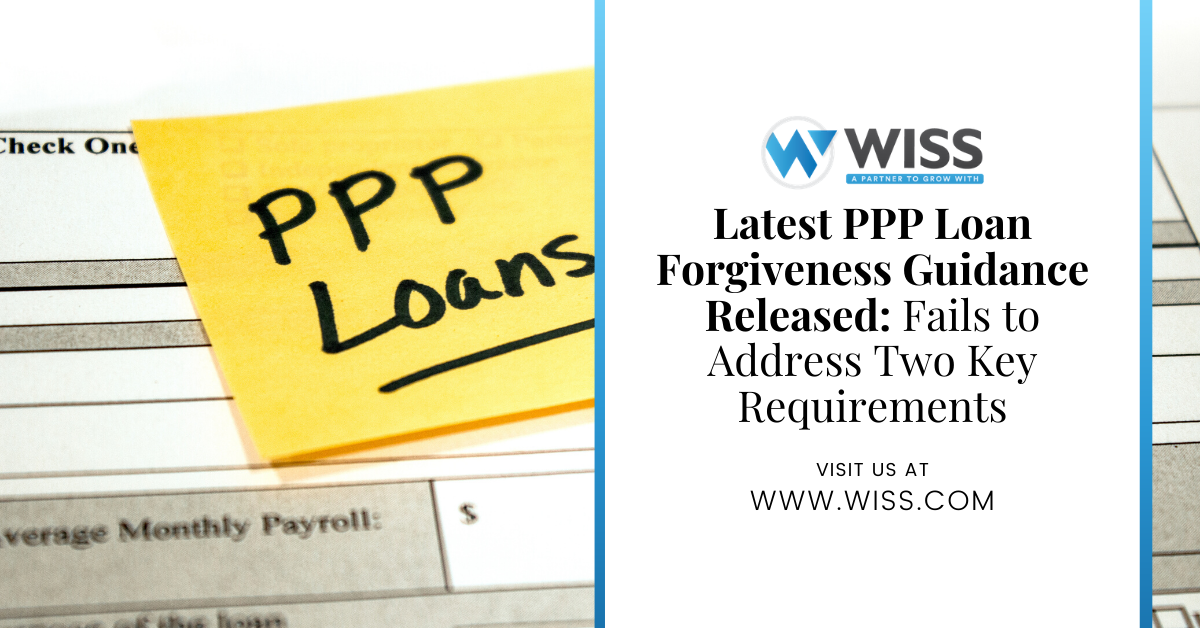On Friday May 22nd, the Small Business Administration (SBA) and the Treasury Department issued two new Interim Final Rules (IFR): one covering Loan Forgiveness and the other covering Loan Review Procedures. The loan forgiveness guidance, which builds upon the loan forgiveness application and instructions that were released May 15th, still does not make changes to provisions for the 75/25 requirement to spend PPP funds on payroll and non-payroll costs, or the 8-week (56-day) covered or alternative payroll covered period. These are arguably the two biggest areas of concern for borrowers who are contemplating applying for loan forgiveness. There are multiple bills working their way through both houses of Congress that would provide relief and more favorable forgiveness terms for borrowers. We expect additional guidance to be issued including FAQs and other Interim Final Rule.
Key highlights and updates from the two interim final rules include:
Loan Forgiveness
- A welcome clarification that payroll costs are defined broadly in the CARES Act, and include bonuses, hazard pay, and commissions, or similar compensation, as long as these costs do not exceed an annual salary of $100,000. Compensation to furloughed employees is also eligible for forgiveness.
- The IFR establishes an alternative time period for determining when the 8-week covered period starts for businesses with biweekly (or more frequent) pay cycles. These borrowers have the option to elect the alternative payroll covered period, which starts the 8 week period on the first day of the pay period after the borrower received their PPP loan. The borrower must continue to use the Covered Period if their pay cycle is less frequent than bi-weekly.
- Payroll costs paid to owner-employees and self-employed individuals is limited to the lesser of 8/52 of 2019 pay or self-employment income, or $15,385. This cap is applicable on a per individual basis, in total, across all businesses. Self-employed individuals, including Schedule C filers and general partners, are not able to include retirement or health insurance contributions in the forgiveness amount. This follows the loan application which excluded health and retirement contributions from the loan amount for self-employed individuals.
- In line with the forgiveness application and instructions, the IFR confirms non-payroll costs must be paid during the 8 week period or incurred during the period and paid on or before the next regular billing date, even if that date is after the 8 weeks.
- The IFR confirms advance payments on mortgage interest are not eligible for loan forgiveness.
- Clarification that reduced headcount will not impact the borrower’s forgiveness amount, if the employee declined a good faith offer to return at the same pay and hours as before they were laid off or furloughed. The IFR includes new guidance which states borrowers must notify the state unemployment office of an employee’s rejected offer of reemployment within 30 days of that rejection. Additional guidance regarding this requirement will be provided on SBA’s website.
- Full-time equivalent is defined as 40 hours, which deviates from existing SBA guidance stating an FTE is defined as 30 hours or more. The IFR states the Administrator felt 40 hours per week is more in line with what constitutes full-time employment for the majority of American workers.
- Two methods to calculate full-time equivalency for employees who were paid for less than 40 hours per week. Borrowers may calculate the average number of hours a part-time employee was paid per week, or, borrowers may elect to use a full-time equivalency of 0.5 for each part-time employee. Borrowers may select only one of the two methods and must apply the same method consistently to all part-time employees for the covered period or the alternative payroll covered period.
- Clarification regarding the two forgiveness penalty provisions, eliminating the possibility that borrowers will be double penalized, for both the salary reduction and FTE reduction penalty provisions. The salary and wage reduction applies only to the portion of the decline in employee salary that is not attributable to the FTE reduction penalty provision.
- Borrowers will not be penalized for reduced headcount if the employee was fired for cause, voluntarily resigns, or voluntarily requests a reduced schedule during the covered period or alternative payroll covered period. Borrowers should count these employees at the same full-time equivalency level when determining the FTE reduction penalty.
Loan Review Procedures
- The IFR establishes that the SBA may review any PPP loan, regardless of size, to determine if the borrower is eligible for a Paycheck Protection Program (PPP) loan, under the CARES Act. The IFR also clarifies the SBA has the ability to review if the applicant calculated the loan amount correctly, if PPP funds were used for eligible costs, and whether the borrower is eligible for the forgiveness amount requested. Keep in mind, the SBA provided a safe harbor for PPP loans of $2MM or less, which provides that these borrowers automatically met the economic uncertainty and business necessity certifications to apply for the loan. While the PPP application is safe harbored if the loan is $2MM or less, the SBA still has the ability to review any loan at any time.
- If the SBA provides an adverse decision, the IFR provides that borrowers may appeal SBA’s decision within 30 days of receipt. The IFR states an appeal process will be established, with additional guidance to be provided at a later date, in a subsequent interim final rule.
- Confirms lenders have 60 days from receipt of a completed forgiveness application to provide a decision to the SBA. The SBA then has 90 days to review the loan forgiveness application and provide a decision to the lender.
- If the SBA determines a borrower was ineligible for a loan, the SBA may seek repayment of the outstanding PPP loan balance or pursue other available remedies.
- The IFR details what a lender must review for the forgiveness application, including the borrower’s calculations for payroll and non-payroll costs. The borrower is required to attest to the accuracy of the forgiveness amount requested, and the lender is required to perform a good-faith review, in reasonable time, of the borrower’s calculations and supporting documents. The IFR provides an example of what constitutes reasonable review: “minimal review of calculations based on a payroll report by a recognized third-party payroll processor would be reasonable”. If payroll costs are not documented by recognized sources, more detailed and thorough review of the borrower’s forgiveness amount and calculations is warranted and expected by SBA.
- After applying for loan forgiveness, the Lender will issue a decision to SBA on the borrower’s loan forgiveness application. The lender can provide a decision as follows: Approval – in whole or in part; Denial; Denial without prejudice due to a pending SBA review of the loan. If the forgiveness application is denied without prejudice, the borrower has the option to request the lender reconsider its application for loan forgiveness, unless the SBA has informed the lender the borrower is ineligible for a PPP loan.
- The IFR confirms that lenders will not be paid their fees for any PPP loans the SBA deems ineligible, and the IFR details a 1-year claw-back provision on bank fees for these loans.

 Previous
Previous






